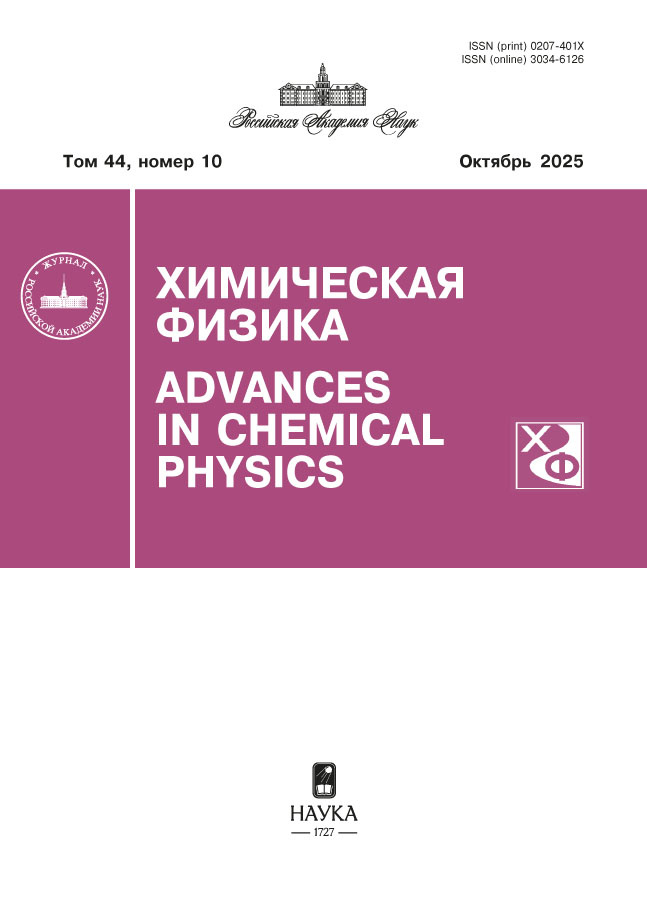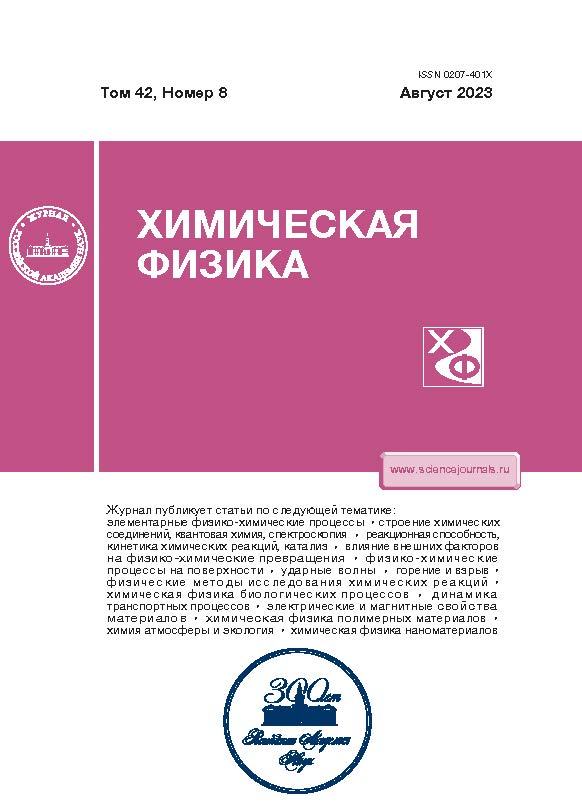Том 42, № 8 (2023)
Горение, взрыв и ударные волны
Модель конвективного режима горения гранулированных смесей, используемых в процессах самораспространяющегося высокотемпературного синтеза
Аннотация
Недавние публикации по горению гранулированной шихты, предназначенной для синтеза композиций на основе карбида титана, выявили значительные изменения характеристик и скорости горения при спутном потоке инертного газа. Авторы исследований связали эти изменения с конвективным режимом горения. В данной работе приведена теоретическая модель, которая позволяет анализировать вклад конвективной передачи тепла при горении гранулированной шихты в спутном потоке газа в процессах самораспространяющегося высокотемпературного синтеза. Показано, что в зависимости от расхода горячего газа, продуваемого сквозь гранулированный образец, возможны три режима горения. При отсутствии или небольшом расходе газа (на уровне 1 кг/м2 · с и ниже) роль конвекции незначительна, а фронт горения в основном плоский. При умеренных расходах (на уровне 10 кг/м2 · с) влияние конвекции становится заметным, скорость горения возрастает вдвое, а фронт горения уже не является плоским, поскольку поверхностные слои гранул разогреваются быстрее, чем слои в центре. Наконец, при высоких расходах (на уровне 50 кг/м2 · с) вклад конвекции становится преобладающим, скорость горения превышает базовую (в отсутствие обдува газом) более чем на порядок величины и происходит значительная перестройка структуры волны горения.
 3-11
3-11


Кинетические модели горения бензина
Аннотация
Рассмотрено современное состояние исследований по разработке кинетических моделей горения бензина и его составляющих. Проанализированы суррогатные модели бензина, которые описывают физические и химические свойства реального топлива и используются при разработке детальных и редуцированных кинетических моделей. Сделан обзор экспериментальных данных, на основе которых проводится тестирование кинетических моделей различной степени сложности. Приведены примеры применения кинетических моделей при численном моделировании процессов, протекающих в двигателях внутреннего сгорания.
 12-26
12-26


Механизм распространения горения в пористых нанотермитах
Аннотация
Процесс быстрого горения наноразмерных пористых смесей Al + CuO в кварцевых трубках исследован с помощью высокоскоростной видеосъемки. Математическая обработка кинограмм, полученных с использованием нейтральных светофильтров разной толщины, позволила определить скорости горения на различных участках трубки и экспериментально оценить размеры зон воспламенения и горения наноразмерного термита. Для объяснения механизма распространения горения предложена простая, основанная на законе Дарси, модель фильтрации горячих продуктов через макропоры. По результатам модельных экспериментов с горением наноразмерного термита в трубках с инертными преградами (стеклянные микросферы, воздушные промежутки) получены данные, которые позволили разработать простой алгоритм оценки проницаемости наноразмерной смеси и давления в зоне горения.
 27-38
27-38


Воздушная газификация древесины при повышенном давлении в режиме фильтрационного горения
Аннотация
Экспериментально исследована воздушная газификация древесины при повышенном давлении в режиме фильтрационного горения. Показано, что повышение давления в реакторе (до 3 атм) при газификации древесины приводит к увеличению производительности экспериментальной установки в 1.6 раза, снижению количества образующих смол в 1.5 раза и изменению концентраций выходящих газов. Проведены термодинамические расчеты влияния давления на стадию пиролиза древесины. С повышением давления от 1 до 9 атм происходит снижение объемных концентраций водорода и монооксида углерода, а объемные концентрации водяного пара и диоксида углерода повышаются. Однако уже при температуре пиролиза 1300 К повышение давления практически не оказывает влияния на состав газообразных продуктов.
 39-44
39-44


Влияние эффекта обтекания зоны энерговыделения на распространение волны светового горения
Аннотация
Рассмотрены причины превышения наблюдаемых скоростей распространения волн светового горения в лазерном плазмотроне в аргоне и воздухе над расчетными в предположении теплопроводностного механизма распространения плазменного фронта. Для интерпретации экспериментальных результатов используется ранее полученное аналитическое решение гидродинамической задачи обтекания объема нагретого газа, моделируемого однородной областью низкой плотности со сферической границей. Установлено, что при мощности лазера в 2–3 раза выше пороговой мощности поддержания волн светового горения теплопроводностный механизм с поправочным коэффициентом, предсказанным моделью, дает удовлетворительное описание наблюдаемых скоростей распространения этих волн. При более высокой мощности лазера соответствие расчетных и наблюдаемых скоростей распространения требует учета фактора радиационной теплопроводности. Показано, что аналитическая модель обтекания сферической области горячего газа может быть также применена для описания на порядок более медленного течения газа вокруг непрерывного оптического разряда при термогравитационной конвекции. На основе рассматриваемой модели получена оценка зависимости частоты пульсаций конвективного факела вокруг непрерывного оптического разряда от его радиуса, представляющая собой соотношение подобия, характерное как для оптических разрядов, так и для мерцающих пламен.
 45-55
45-55


Имитация действия взрыва в ударной трубе с фокусирующим элементом
Аннотация
Выполнен анализ результатов экспериментов, полученных в цилиндрической ударной трубе, оборудованной в торце фокусирующим элементом в виде усеченного конуса. Установлено, что в вершине конуса максимальное давление многократно превышает давление при отражении ударной волны от плоской стенки. Получено хорошее согласие между измеренными профилями давления и результатами численного моделирования фокусировки ударной волны, проведенного с помощью пакета GasDynamicsTool в трехмерной постановке. Показано, что зависимость давления от времени при фокусировке подобна наблюдаемой при нормальном отражении ударной волны, генерируемой взрывом заряда тринитротолуола. Полученные результаты и разработанная методика позволяют проводить имитацию фугасного действия взрыва без использования конденсированных взрывчатых веществ.
 56-60
56-60


Параметры волн давления при разрыве подводных газопроводов
Аннотация
В работе численно исследованы параметры ударных волн, образующихся при расширении цилиндрических объемов сжатого метана в случае, когда сжатый газ находится в воде. Такая задача моделирует разрыв подводных газопроводов. Сжатый метан рассматривался при давлении 10.1 МПа, типичном для систем магистральных трубопроводов. Получены зависимости давления от расстояния от оси трубопровода в волнах в окружающей водной массе. При этом в волнах в воде наблюдается характерный для цилиндрической геометрии “горбовидный” профиль. Рассмотрено взаимодействие волн при выходе на свободную поверхность и при прохождении слоя стали.
 61-67
61-67


Структура ламинарного пламени в бедных смесях водорода с воздухом
Аннотация
Проведены численное моделирование структуры и расчеты скорости распространения ламинарного пламени, SL, в бедной смеси водорода (12%) с воздухом при нормальных начальных условиях. Анализ профилей концентраций промежуточных продуктов показывает, что с ростом температуры происходит смена кинетического механизма, определяющего динамику тепловыделения. Таким образом, процесс тепловыделения в пламени состоит из двух этапов. В области максимального градиента температуры концентрации H2O2 и HO2 достигают пиковых значений. Последующая убыль содержаний H2O2 и HO2 сопровождается симбатным ростом концентраций H, O и OH. При изменении констант скоростей реакций, определяющих тепловыделение, изменяются скорость нарастания температуры и значение SL. Последнее наиболее чувствительно к реакции молекулярного водорода с гидроксилом с образованием воды.
 68-73
68-73


Особенности воспламенения смесей водорода с углеводородами С2, С3, С5 над родием и палладием при давлениях 1–2 атм
Аннотация
Установлено, что определяющим фактором каталитического воспламенения смесей водорода с этаном и этиленом является химическая природа не только катализатора, но и углеводорода С2 в смеси с Н2. Показано, что пределы каталитического воспламенения синтез-газа над поверхностью металлического родия качественно отличаются от зависимостей для смесевого горючего водород–углеводород. Зависимость нижнего предела каталитического воспламенения от температуры имеет отчетливый максимум, что указывает на более сложный механизм каталитического процесса, чем в случае смесей водород–метан. Аррениусовская зависимость ln[H2]lim от 1/T не выполняется. Поэтому следует уточнить интерпретацию верхнего и нижнего пределов каталитического воспламенения, принятую в литературе. Относительно длительные периоды задержки каталитического воспламенения смесей водород–н-пентан (десятки секунд) и отсутствие их зависимости от начальной температуры позволяют сделать вывод, что каталитическое воспламенение смесей водород–пропан/н-пентан определяется скоростью переноса молекул углеводорода к поверхности каталитической проволоки. Таким образом, при окислении смесей водород–углеводород для легких углеводородов основным фактором, определяющим каталитическое воспламенение, является реакция окисления водорода на каталитической поверхности. При увеличении числа атомов углерода в углеводороде значительную роль начинают играть факторы, связанные с химической структурой (т.е. с реакционной способностью углеводорода при каталитическом окислении), и затем скорость окисления уже определяется скоростью диффузии углеводорода к поверхности катализатора.
 74-81
74-81


Рекомбинационный механизм нагрева примесных микрочастиц в процессе инициирования низкотемпературного воспламенения
Аннотация
Проведен анализ вклада от рекомбинации радикалов на поверхности примесной микрочастицы, находящейся в реагирующей смеси водород/кислород/аргон либо пропан/кислород/аргон, в нагрев микрочастицы. Проведена оценка возможного ускорения воспламенения от точечного очага в виде нагретой микрочастицы при температурах 800–1100 К в условиях, при которых наблюдается уменьшение задержек воспламенения в экспериментах в ударных трубах и установках быстрого сжатия. Показано, что в зависимости от размера микрочастицы и концентрации радикалов в смеси рекомбинационный нагрев микрочастицы на ранних стадиях горения может составлять от десятка до сотни градусов. Это может приводить к уменьшению задержки воспламенения в несколько раз. Предложенный механизм может быть рассмотрен как одна из возможностей устранения расхождения между экспериментально наблюдаемыми и рассчитываемыми с помощью детального кинетического механизма задержками воспламенения в указанных условиях.
 82-86
82-86


Химическая физика наноматериалов
Термическая стабильность пассивированных компактов из пирофорных нанодисперсных порошков железа
Аннотация
Из пирофорного нанодисперсного порошка железа в перчаточном боксе в атмосфере аргона изготовляли компактные образцы диаметрами 3 и 5 мм, которые помещали в бюксы с притертой крышкой. Порошок железа получали химико-металлургическим методом. Средний размер наночастиц порошка составлял 85 нм. Установлено, что в процессе нахождения бюксов с образцами на воздухе происходила пассивация образцов с сохранением их высокой химической активности, так как при инициировании реакции окисления высокотемпературным источником по образцу запускалась волна горения со скоростью порядка 0.25 мм / с. Выдержка пассивированных образцов диаметром 5 мм в течение 60 мин при температуре 110 °С не привела к изменению фазового состава образца. Выдержка при температуре 180 °С в течение 30 мин привела к изменению цвета образца и его окислению. Эксперименты с пассивированными образцами диаметром 3 мм показали, что в условиях программируемого нагрева воспламенение образцов происходит при температуре около 100 °С Проведенные исследования позволяют говорить о термостабильности полученных компактных образцов из нанопорошка железа при температуре ниже 100 °С, когда не требуется каких-либо особых температурных условий для их безопасного хранения и транспортировки.
 87-94
87-94













